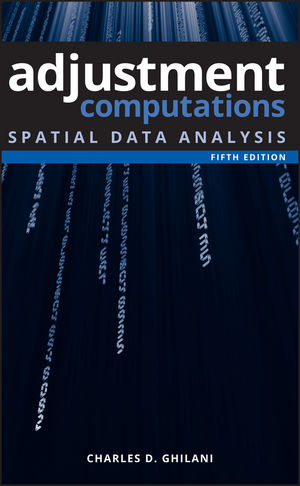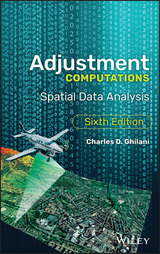
Adjustment Computations
John Wiley & Sons Ltd (Verlag)
978-0-470-46491-5 (ISBN)
- Titel erscheint in neuer Auflage
- Artikel merken
CHARLES D. GHILANI, PhD, is Professor of Engineering in the Surveying Engineering program at The Pennsylvania State University.
PREFACE xv
ACKNOWLEDGMENTS xix
1 Introduction 1
1.1. Introduction 1
1.2. Direct and Indirect Measurements 2
1.3. Measurement Error Sources 2
1.4. Definitions 3
1.5. Precision versus Accuracy 4
1.6. Redundant Observations in Surveying and Their Adjustment 6
1.7. Advantages of Least Squares Adjustment 8
1.8. Overview of the Book 9
Problems 10
2 Observations and Their Analysis 12
2.1. Introduction 12
2.2. Sample versus Population 12
2.3. Range and Median 13
2.4. Graphical Representation of Data 14
2.5. Numerical Methods of Describing Data 17
2.6. Measures of Central Tendency 17
2.7. Additional Definitions 18
2.8. Alternative Formula for Determining Variance 21
2.9. Numerical Examples 22
2.10. Derivation of the Sample Variance (Bessel’s Correction) 26
2.11. Software 28
Problems 29
Practical Exercises 32
3 Random Error Theory 33
3.1. Introduction 33
3.2. Theory of Probability 33
3.3. Properties of the Normal Distribution Curve 36
3.4. Standard Normal Distribution Function 38
3.5. Probability of the Standard Error 41
3.6. Uses for Percent Errors 43
3.7. Practical Examples 44
Problems 46
Programming Problems 48
4 Confidence Intervals 49
4.1. Introduction 49
4.2. Distributions Used in Sampling Theory 51
4.3. Confidence Interval for the Mean: t statistic 55
4.4. Testing the Validity of the Confidence Interval 58
4.5. Selecting a Sample Size 59
4.6. Confidence Interval for a Population Variance 60
4.7. Confidence Interval for the Ratio of Two Population Variances 61
4.8. Software 64
Problems 66
5 Statistical Testing 70
5.1. Hypothesis Testing 70
5.2. Systematic Development of a Test 73
5.3. Test of Hypothesis for the Population Mean 74
5.4. Test of Hypothesis for the Population Variance 76
5.5. Test of Hypothesis for the Ratio of Two Population Variances 79
5.6. Software 82
Problems 83
6 Propagation of Random Errors in Indirectly Measured Quantities 86
6.1. Basic Error Propagation Equation 86
6.2. Frequently Encountered Specific Functions 91
6.3. Numerical Examples 92
6.4. Software 96
6.5. Conclusions 98
Problems 98
Practical Exercises 102
7 Error Propagation in Angle and Distance Observations 103
7.1. Introduction 103
7.2. Error Sources in Horizontal Angles 103
7.3. Reading Errors 104
7.4. Pointing Errors 106
7.5. Estimated Pointing and Reading Errors with Total Stations 107
7.6. Target–Centering Errors 108
7.7. Instrument–Centering Errors 110
7.8. Effects of Leveling Errors in Angle Observations 113
7.9. Numerical Example of Combined Error Propagation in a Single Horizontal Angle 116
7.10. Using Estimated Errors to Check Angular Misclosure in a Traverse 117
7.11. Errors in Astronomical Observations for Azimuth 119
7.12. Errors in Electronic Distance Observations 124
7.13. Software 125
Problems 126
Programming Problems 130
8 Error Propagation in Traverse Surveys 131
8.1. Introduction 131
8.2. Derivation of Estimated Error in Latitude and Departure 132
8.3. Derivation of Estimated Standard Errors in Course Azimuths 134
8.4. Computing and Analyzing Polygon Traverse Misclosure Errors 134
8.5. Computing and Analyzing Link Traverse Misclosure Errors 140
8.6. Software 144
8.7. Conclusions 145
Problems 145
Programming Problems 150
9 Error Propagation in Elevation Determination 151
9.1. Introduction 151
9.2. Systematic Errors in Differential Leveling 151
9.3. Random Errors in Differential Leveling 154
9.4. Error Propagation in Trigonometric Leveling 159
Problems 162
Programming Problems 164
10 Weights of Observations 165
10.1. Introduction 165
10.2. Weighted Mean 167
10.3. Relation between Weights and Standard Errors 169
10.4. Statistics of Weighted Observations 169
10.5. Weights in Angle Observations 171
10.6. Weights in Differential Leveling 171
10.7. Practical Examples 173
Problems 175
11 Principles of Least Squares 178
11.1. Introduction 178
11.2. Fundamental Principle of Least Squares 179
11.3. Fundamental Principle of Weighted Least Squares 181
11.4. Stochastic Model 182
11.5. Functional Model 183
11.6. Observation Equations 184
11.7. Systematic Formulation of the Normal Equations 186
11.8. Tabular Formation of the Normal Equations 188
11.9. Using Matrices to Form Normal Equations 189
11.10. Least Squares Solution of Nonlinear Systems 192
11.11. Least Squares Fit of Points to a Line or Curve 195
11.12. Calibration of an EDM Instrument 199
11.13. Least Squares Adjustment Using Conditional Equations 200
11.14. The Previous Example Using Observation Equations 202
11.15. Software 203
Problems 204
12 Adjustment of Level Nets 210
12.1. Introduction 210
12.2. Observation Equation 210
12.3. Unweighted Example 211
12.4. Weighted Example 214
12.5. Reference Standard Deviation 216
12.6. Another Weighted Adjustment 218
12.7. Software 221
Problems 223
Programming Problems 227
13 Precisions of Indirectly Determined Quantities 228
13.1. Introduction 228
13.2. Development of the Covariance Matrix 228
13.3. Numerical Examples 232
13.4. Standard Deviations of Computed Quantities 233
Problems 236
Programming Problems 239
14 Adjustment of Horizontal Surveys: Trilateration 240
14.1. Introduction 240
14.2. Distance Observation Equation 242
14.3. Trilateration Adjustment Example 244
14.4. Formulation of a Generalized Coefficient Matrix for a More Complex Network 250
14.5. Computer Solution of a Trilaterated Quadrilateral 251
14.6. Iteration Termination 255
14.7. Software 256
Problems 258
Programming Problems 264
15 Adjustment of Horizontal Surveys: Triangulation 266
15.1. Introduction 266
15.2. Azimuth Observation Equation 266
15.3. Angle Observation Equation 269
15.4. Adjustment of Intersections 271
15.5. Adjustment of Resections 276
15.6. Adjustment of Triangulated Quadrilaterals 282
Problems 287
Programming Problems 296
16 Adjustment of Horizontal Surveys: Traverses and Horizontal Networks 298
16.1. Introduction to Traverse Adjustments 298
16.2. Observation Equations 298
16.3. Redundant Equations 299
16.4. Numerical Example 300
16.5. Minimum Amount of Control 306
16.6. Adjustment of Networks 307
16.7. χ2 Test: Goodness of Fit 315
Problems 316
Programming Problems 326
17 Adjustment of GNSS Networks 327
17.1. Introduction 327
17.2. GNSS Observations 328
17.3. GNSS Errors and the Need for Adjustment 330
17.4. Reference Coordinate Systems for GNSS Observations 331
17.5. Converting between the Terrestrial and Geodetic Coordinate Systems 334
17.6. Application of Least Squares in Processing GNSS Data 337
17.7. Network Preadjustment Data Analysis 340
17.8. Least Squares Adjustment of GNSS Networks 346
Problems 352
Programming Problems 366
18 Coordinate Transformations 368
18.1. Introduction 368
18.2. Two–Dimensional Conformal Coordinate 368
18.3. Equation Development 369
18.4. Application of Least Squares 371
18.5. Two–Dimensional Affine Coordinate Transformation 374
18.6. Two–Dimensional Projective Coordinate Transformation 377
18.7. Three–Dimensional Conformal Coordinate Transformation 380
18.8. Statistically Valid Parameters 386
Problems 390
Programming Problems 396
19 Error Ellipse 397
19.1. Introduction 397
19.2. Computation of Ellipse Orientation and Semiaxes 399
19.3. Example Problem of Standard Error Ellipse Calculations 404
19.4. Another Example Problem 406
19.5. Error Ellipse Confidence Level 407
19.6. Error Ellipse Advantages 409
19.7. Other Measures of Station Uncertainty 412
Problems 413
Programming Problems 415
20 Constraint Equations 416
20.1. Introduction 416
20.2. Adjustment of Control Station Coordinates 416
20.3. Holding Control Fixed in a Trilateration Adjustment 421
20.4. Helmert’s Method 424
20.5. Redundancies in a Constrained Adjustment 429
20.6. Enforcing Constraints through Weighting 429
Problems 431
Practical Exercises 434
21 Blunder Detection in Horizontal Networks 435
21.1. Introduction 435
21.2. A Priori Methods for Detecting Blunders in Observations 436
21.3. A Posteriori Blunder Detection 438
21.4. Development of the Covariance Matrix for the Residuals 439
21.5. Detection of Outliers in Observations: Data Snooping 442
21.6. Detection of Outliers in Observations: The Tau Criterion 444
21.7. Techniques Used In Adjusting Control 444
21.8. Data Set with Blunders 446
21.9. Further Considerations 453
21.10. Survey Design 455
21.11. Software 457
Problems 458
Practical Exercises 462
22 General Least Squares Method and Its Application to Curve Fitting and Coordinate
Transformations 464
22.1. Introduction to General Least Squares 464
22.2. General Least Squares Equations for Fitting a Straight Line 464
22.3. General Least Squares Solution 466
22.4. Two–Dimensional Coordinate Transformation by General Least Squares 470
22.5. Three–Dimensional Conformal Coordinate Transformation by General Least Squares 476
Problems 478
Programming Problems 482
23 Three–Dimensional Geodetic Network Adjustment 483
23.1. Introduction 483
23.2. Linearization of Equations 485
23.3. Minimum Number of Constraints 490
23.4. Example Adjustment 490
23.5. Building an Adjustment 499
23.6. Comments on Systematic Errors 499
23.7. Software 502
Problems 503
Programming Problems 507
24 Combining GPS and Terrestrial Observations 508
24.1. Introduction 508
24.2. Helmert’s Transformation 510
24.3. Rotations between Coordinate Systems 513
24.4. Combining GPS Baseline Vectors with Traditional Observations 514
24.5. Another Approach to Transforming Coordinates between Reference Frames 518
24.6. Other Considerations 521
Problems 522
Programming Problems 524
25 Analysis of Adjustments 525
25.1. Introduction 525
25.2. Basic Concepts, Residuals, and the Normal Distribution 525
25.3. Goodness–of–Fit Test 528
25.4. Comparison of Residual Plots 531
25.5. Use of Statistical Blunder Detection 533
Problems 534
26 Computer Optimization 536
26.1. Introduction 536
26.2. Storage Optimization 536
26.3. Direct Formation of the Normal Equations 539
26.4. Cholesky Decomposition 540
26.5. Forward and Back Solutions 542
26.6. Using the Cholesky Factor to Find the Inverse of the Normal Matrix 543
26.7. Spareness and Optimization of the Normal Matrix 545
Problems 549
Programming Problems 549
Appendix A Introduction to Matrices 550
A.1. Introduction 550
A.2. Definition of a Matrix 550
A.3. Size or Dimensions of a Matrix 551
A.4. Types of Matrices 552
A.5. Matrix Equality 553
A.6. Addition or Subtraction of Matrices 554
A.7. Scalar Multiplication of a Matrix 554
A.8. Matrix Multiplication 554
A.9. Computer Algorithms for Matrix Operations 557
A.10. Use of the MATRIX Software 560
Problems 562
Programming Problems 564
Appendix B Solution of Equations by Matrix Methods 565
B–1. Introduction 565
B–2. Inverse Matrix 565
B–3. Inverse of a 2 × 2 Matrix 566
B–4. Inverses by Adjoints 568
B–5. Inverses by Elementary Row Transformation 569
B–6. Example Problem 573
Problems 574
Programming Problems 575
Appendix C Nonlinear Equations and Taylor’s Theorem 576
C.1. Introduction 576
C.2. Taylor Series Linearization of Nonlinear Equations 576
C.3. Numerical Example 577
C.4. Using Matrices to Solve Nonlinear Equations 579
C.5. Simple Matrix Example 580
C.6. Practical Example 581
C.7. Concluding Remarks 583
Problems 584
Programming Problems 585
Appendix D Normal Error Distribution Curve and Other Statistical Tables 586
D.1. Development of the Normal Distribution Curve Equation 586
D.2. Other Statistical Tables 594
Appendix E Confidence Intervals for the Mean 606
Appendix F Map Projection Coordinate Systems 612
F.1. Introduction 612
F.2. Mathematics of the Lambert Conformal Conic Map Projection 613
F.3. Mathematics from the Transverse Mercator 616
F.4. Stereographic Map Projection 619
F.5. Reduction of Observations 621
Appendix G Companion Web Site 625
G.1. Introduction 625
G.2. File Formats and Memory Matters 626
G.3. Software 626
G.4. Using the Software as an Instructional Aid 630
Appendix H Solutions to Selected Problems 631
BIBLIOGRAPHY 636
INDEX 639
| Erscheint lt. Verlag | 9.4.2010 |
|---|---|
| Verlagsort | Chichester |
| Sprache | englisch |
| Maße | 161 x 242 mm |
| Gewicht | 1050 g |
| Themenwelt | Naturwissenschaften ► Geowissenschaften ► Geografie / Kartografie |
| Technik | |
| ISBN-10 | 0-470-46491-7 / 0470464917 |
| ISBN-13 | 978-0-470-46491-5 / 9780470464915 |
| Zustand | Neuware |
| Haben Sie eine Frage zum Produkt? |
aus dem Bereich



